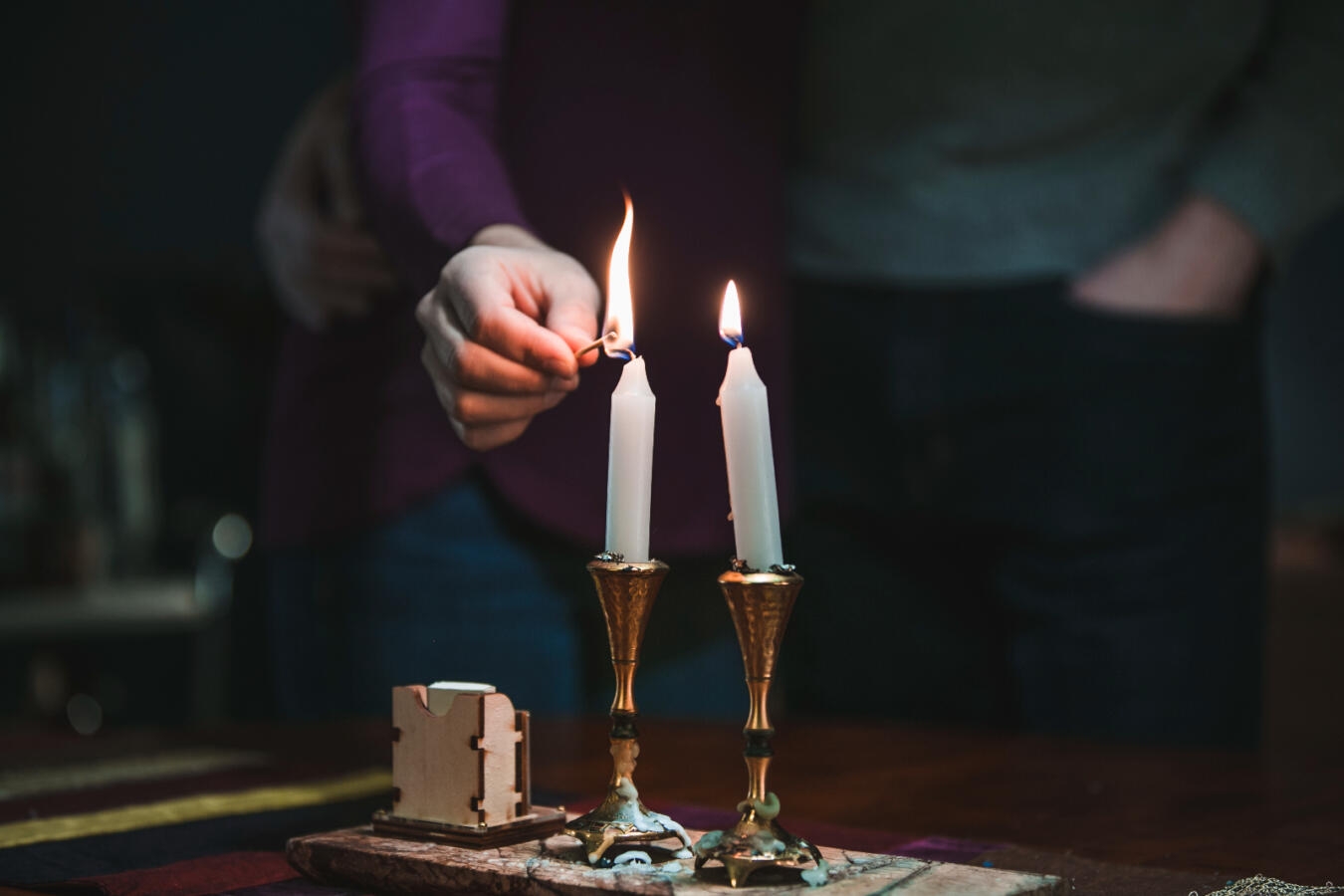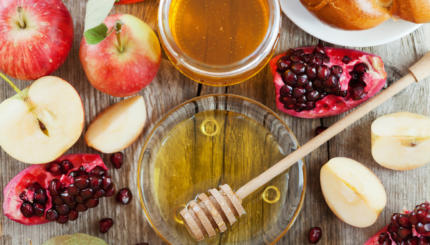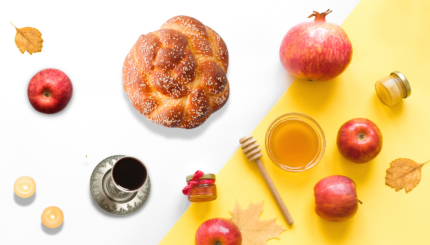The celebration of Rosh Hashanah, the Jewish new year, begins with lighting candles (hadlakat nerot) to symbolize the transition to sacred time.
Jewish law only requires that one candle is lit, but many people light two candles. Another widespread tradition is to light two candles and an additional candle for each member of the household.
It is also traditional to light a yahrzeit or other long-burning candle right before lighting first night candles so that one can transfer the flame when lighting candles on the second night, and thereby avoid striking a match or igniting a lighter, both of which would violate Rosh Hashanah’s work prohibition.
How to light candles on the first night of Rosh Hashanah when it’s not Shabbat
Candles are typically lit in one’s home eighteen minutes before sunset. The candles are lit first, and then the following blessing is recited:
With your help, My Jewish Learning can provide endless opportunities for learning, connection and discovery.
בָּרוּךְ אַתָּה יְיָ אֱלֹהֵינוּ מֶֽלֶךְ הָעוֹלָם אֲשֶׁר קִדְּשָׁנוּ בְּמִצְוֹתָיו וְצִוָּנוּ לְהַדְלִיק נֵר שֶׁל יוֹם טוֹב
Baruch atah Adonai, Eloheinu Melech ha-olam, asher kidshanu b’mitzvotav vitzivanu l’hadlik ner shel yom tov.
Blessed are You, Lord our God, Ruler of the world, who sanctifies us with mitzvot and commands us to kindle the lights of Shabbat and the festival.
After the blessing over the candles, the Shehechiyanu blessing is recited. Shehechiyanu is said whenever one does a mitzvah for the first time in a long time — on Rosh Hashanah, the blessing is recited to mark lighting candles for the first time in the new year.
בָּרוּךְ אַתָּה יְיָ אֱלֹהֵֽינוּ מֶלֶךְ הָעוֹלָם, שֶׁהֶחֱיָֽינוּ וְקִיְּמָנוּ וְהִגִּיעָנוּ לַזְּמָן הַזֶּה
Baruch Atah Adonai, Eloheinu Melech ha-olam, shehechiyanu, v’kiy’manu, v’higianu lazman hazeh.
Blessed are You, Lord our God, Ruler of the world, who has given us life, sustained us and allowed us to arrive in this moment.
When the first night of Rosh Hashanah falls on Shabbat
The beginning of Rosh Hashanah and Shabbat are both marked by lighting candles. When Rosh Hashanah begins on a Friday night, candles are lit and a blessing for both holidays is recited. This is the Sephardi version of the blessing:
בָּרוּךְ אַתָּה יְיָ אֱלֹהֵינוּ מֶֽלֶךְ הָעוֹלָם אֲשֶׁר קִדְּשָׁנוּ בְּמִצְוֹתָיו וְצִוָּנוּ לְהַדְלִיק נֵר שֶׁל שַׁבָּת וְיוֹם טוֹב
Baruch atah Adonai, Eloheinu Melech ha-olam, asher kidshanu b’mitzvotav vitzivanu l’hadlik ner shel Shabbat v’yom tov.
Blessed are You, Lord our God, Ruler of the world, who sanctifies us with mitzvot and commands us to kindle the lights of Shabbat and the festival.
The Ashkenazi version is nearly identical, but adds an extra word shel (meaning “of”):
בָּרוּךְ אַתָּה יְיָ אֱלֹהֵינוּ מֶֽלֶךְ הָעוֹלָם אֲשֶׁר קִדְּשָׁנוּ בְּמִצְוֹתָיו וְצִוָּנוּ לְהַדְלִיק נֵר שֶׁל שַׁבָּת וְשֶׁל יוֹם טוֹב
Baruch atah Adonai, Eloheinu Melech ha-olam, asher kidshanu b’mitzvotav vitzivanu l’hadlik ner shel Shabbat v’shel yom tov.
Blessed are You, Lord our God, Ruler of the world, who sanctifies us with mitzvot and commands us to kindle the lights of Shabbat and of the festival.
Since the Rosh Hashanah candles were lit for the first time that year, in all traditions the Shehechiyanu blessing is then recited.
Lighting candles on the second night of Rosh Hashanah
It is traditional to light candles on the second night of Rosh Hashanah as well as the first. The procedure is the same except that instead of lighting from a match or lighter, it is traditional to light from a pre-existing flame (which is why many people light a yahrzeit candle right before they light their first night Rosh Hashanah candles). You can transfer the flame with an extra candle and this avoids violating Rosh Hashanah’s work prohibition.
If the second night of Rosh Hashanah is a Saturday night, the candles are lit only after Shabbat is over — 42 minutes past sunset or later. However, if it is any other night, they are lit before sundown.
On the second night, it is traditional to taste a fruit that one has not tasted in a long time. It can be a fruit you’ve never tried, or simply one you haven’t had yet that season. The reason is that this fruit provides an opportunity to say Shehechiyanu, the blessing for new experiences, again on the second night. Place the fruit on the table next to the candles, light your candles and then say the blessing for the candles followed by Shehechiyanu as you did on the first night. The fruit can then be tasted when you have your meal following candle-lighting.
Want to learn more about the High Holidays? Sign up for a special High Holiday prep email series.



